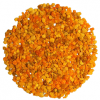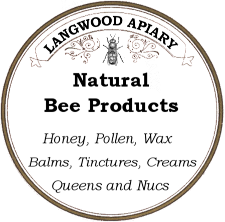
The surface of the pollen grains is uneven and sticky, so the pollen easily sticks to the bee and other insects and thus spreads to other flowers, carrying out their pollination. Some plants do not use the services of insects and are pollinated by the wind. The role of insects in pollinating fruit and vegetable crops is enormous; thanks to them the crop yield can increase by 30–200% and even 1000%.
The pollen grain as a germ cell, an element of the vital origin, is provided by nature with all the necessary substances – proteins, fats, carbohydrates, the most valuable amino acids, micro elements, enzymes, hormones and growth factors. It is important that these substances are found in the pollen in a balanced ratio, in the correspondence that is so necessary for both plants and living organisms. Possessing such a complex composition, the pollen of plants turned out to be a unique biological product for both insects and humans. The content of compound substances in different types of pollen is different, which should be taken into account in medical practice.
The attention to pollen as a healing factor attracted scientists only in the middle of the last century. However, beekeepers and individual physicians for centuries before intuitively knew about its extreme usefulness of pollen to health. Conducting statistical studies, academician N. Tsitsin (1946, USSR) found that the majority of centenarians, turned out to be beekeepers, ate pollen besides honey every day. The performed biological studies of this beekeeping product (R. Shoven, 1956; A. Kayas, 1975; B. Tolpay, 1985) confirmed the presence of the most valuable, vital substances in it. Materials of laboratory and clinical observations of many scientists, as well as medical practitioners on the use of pollen for medicinal purposes, were presented at several symposiums on apitherapy (1974, Bucharest; 1976, Madrid; 1978, Portoroz).
Biological Value of Pollen
The biological value of pollen is very high and is due to the content in it from 7 to 30% of proteins – (albumin, amino acids), 25-48% of carbohydrates, up to 10% of fats. 100 g of pollen contains as many amino acids as 1 kg of beef or 7 chicken eggs, and 30 g of pollen covers the daily human need for amino acids. A. Kaile found in amino acid pollen such amino acids as isoleucine, leucine, lysine, methionine, phenylalanine, threonine, tryptophan, and valine. For example, 30 g of pollen contains 2.2 g of leucine, which is 2 times the daily human need for this amino acid. The daily human need for methionine 2.2 g can satisfy 12 g of pollen. In total, out of 22 essential amino acids for humans, 20 can be found in pollen. Different types of pollen can contain different amounts of amino acids. The saturation of pollen with vitamins also varies, depending on the type of plant, the region where it was collected, the time of collection and many other factors.
The mineral composition of pollen is very diverse; 28 elements of the periodic table are found in it. The following elements predominate in the ash residue: potassium – 20-40%, magnesium – 1-20%, calcium – 1-15%, iron – 1-12%, silicon -2-10%, phosphorus – 1-20%.
Pollen humidity ranges from 12 to 20%, it contains glucose – 11%, fructose – 18%.
Certain types of pollen are most useful in certain types of pathology, which must be considered in clinical practice. For example:
- pollen of acacia and linden has sedative properties;
- dog rose pollen increases urination, has a destructive effect on kidney stones;
- dandelion pollen has a diuretic and laxative effect;
- apple pollen has a beneficial effect on the myocardium, has a tonic effect;
- blackberry pollen tones well, reduces intestinal peristalsis;
- cornflower pollen increases urination, is useful for gout, rheumatism.
It is not always possible to find monofleric pollen for the intended treatment purpose because monofleric pollen can only be collected when the beehives are near a field planted with monoculture. More often, we are dealing with polyfleral pollen with a wide range of therapeutic effects.
